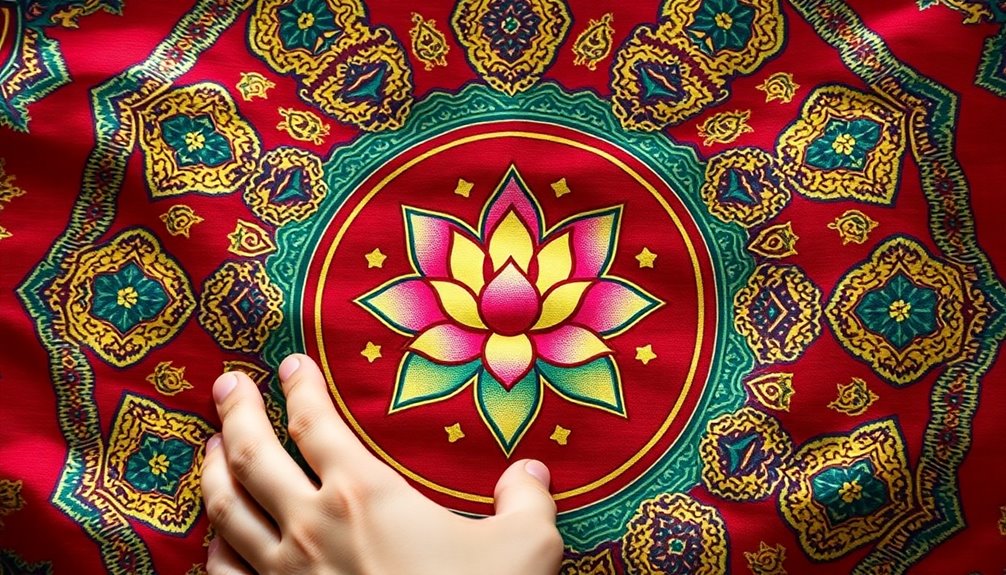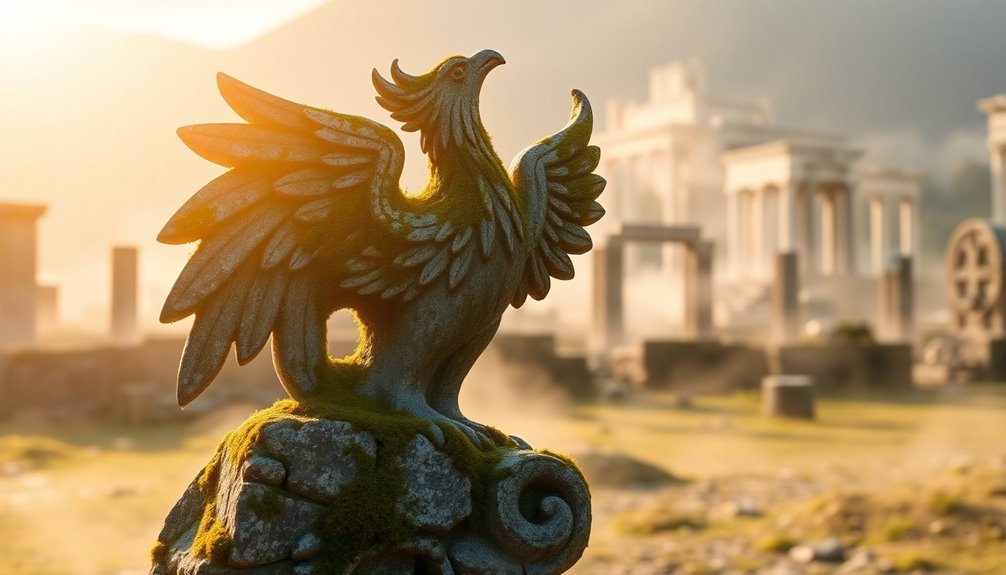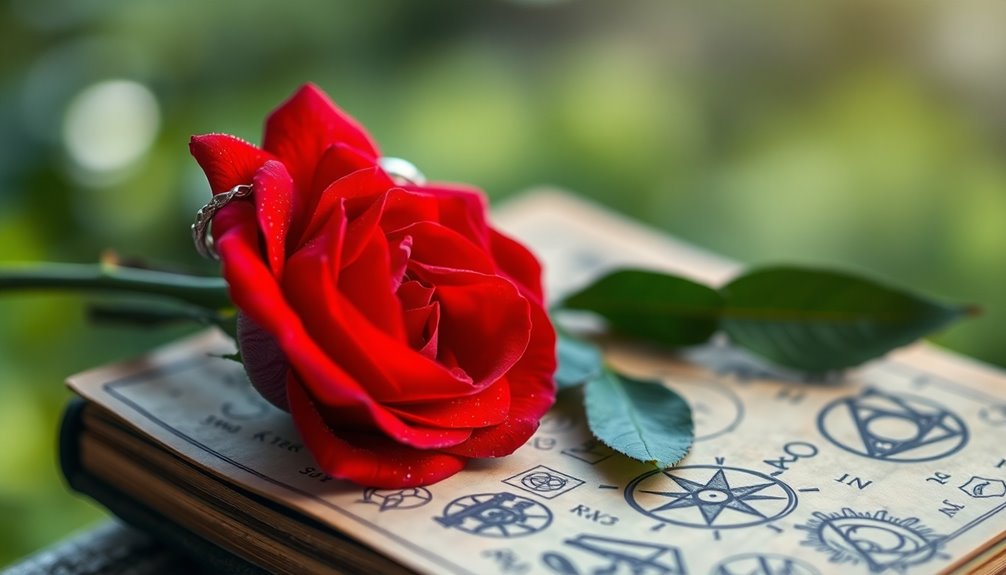Symbolism means using symbols to express big ideas and feelings. You can find symbols in art, stories, or even everyday life! For example, a red heart often stands for love, while a key can represent opportunity. Authors and artists use symbols to give their work deeper meanings, like how Fitzgerald's green light in *The Great Gatsby* symbolizes dreams. Different cultures also have unique symbols that show their values or traditions. Sometimes, symbols can be misunderstood, so context is important! If you explore further, you'll discover even more fascinating ways symbols enrich our understanding of the world.
Key Takeaways
- Symbolism represents ideas or concepts through symbols, allowing for deeper meanings and multiple interpretations.
- Different types of symbolism include romantic, religious, emotional, event, and physical object symbolism.
- In literature and art, symbols are used to convey complex themes and emotions, enhancing the narrative or visual impact.
- Cultural significance plays a role in understanding symbols, as meanings can vary across contexts and societies.
- Misinterpretation can occur if symbols are taken literally or without considering their historical and cultural context.
Definition of Symbolism

Symbolism, as an expressive art form, uses symbols to represent ideas and convey deeper meanings that go beyond their literal interpretations. It's like a secret language! When you see a bright red heart, you might think of love or passion. That's symbolism at work! Symbols help us understand abstract ideas that can sometimes be tricky to express with just words.
Imagine a key. It mightn't just be a tool for accessing doors; it can symbolize access or opportunity in your life. This is what makes symbolism so exciting! Each symbol can carry different meanings depending on where and how it's used.
Sometimes, you'll find that symbols can be a bit confusing. They can have multiple meanings, which adds to their charm. This can lead to interesting conversations about what a symbol means to you versus someone else.
Symbols also connect cultures, helping people share feelings and thoughts across different societies.
Types of Symbolism

Throughout literature and art, various types of symbolism emerge, each serving a unique purpose in conveying deeper meanings. One popular type is romantic symbolism, where symbols like roses represent love and affection. You often find this in poetry and stories about relationships.
Another type is religious symbolism, which uses symbols recognized in different faiths. For example, the cross in Christianity or the lotus in Buddhism conveys important spiritual ideas.
Emotional symbolism is also fascinating. It uses colors or objects to show feelings—like how black can symbolize death or blue can represent calmness.
Then, there's symbolism through events. Think about weddings or graduations; these moments symbolize major life changes and transformations.
Lastly, physical object symbolism plays a significant role in our lives. Everyday items, like keys, can symbolize access or opportunity, while wedding rings often stand for commitment and love.
Understanding these types of symbolism helps you appreciate the deeper meanings behind what you see and feel. It's exciting to explore how symbolism can describe our experiences, thoughts, and emotions in such rich and varied ways!
Symbolism in Literature

Literary symbolism serves as a powerful tool for authors, allowing them to weave intricate themes and emotions into their narratives. When you read a story, you might notice that certain objects, colors, or animals carry special meanings. These symbols can represent something much deeper than their literal definition. For example, in F. Scott Fitzgerald's *The Great Gatsby*, the green light symbolizes unattainable dreams, showing the struggles of the characters.
In poetry, symbolism includes vivid images that evoke strong feelings. Poets like William Blake use symbols to express big ideas about life and human experiences. This helps you connect with the emotions behind the words.
As you explore a book, keep in mind that the interpretation of symbols can change. You'll need to engage deeply with the text to uncover hidden meanings and understand the characters better. This journey can be exciting!
Symbolism in Art

Art is like a secret code, using symbols to share big ideas and feelings.
You might notice how colors, shapes, and even the way things are arranged tell a story or express emotions.
When you look closely at a painting or sculpture, you'll see how artists use these symbols to connect with you in a special way!
Visual Representation of Ideas
When you step into a gallery or gaze at a piece of art, you often find yourself drawn to the layers of meaning behind familiar images. Artists use symbols to represent big ideas and feelings. These symbols can be simple, like a heart for love, or complex, like a tree representing life. By using recognizable images, artists help you connect with emotions that might be hard to express in words.
Color is another powerful tool in art. Artists choose colors carefully to create moods. For example, bright red can spark feelings of passion, while soft blue can bring a sense of calm and peace. The colors you see can change how you feel about a piece of art.
Modern art takes things a step further by challenging your ideas. It often uses unexpected symbols that make you think deeply. Sculptures, too, can share meaning through their shapes and materials, turning abstract concepts into something you can see and touch.
Iconography in Artistic Contexts
Symbols in art serve not just as visual elements but also as storytelling devices that convey deeper meanings. When you look at a painting or sculpture, think about the symbols used.
These symbols, part of a fascinating thing called iconography, help tell a story beyond what you see on the surface. For example, a lamb might symbolize innocence, while a skull can represent mortality. These images evoke feelings and provoke thought.
Iconography can change from one culture to another and across different time periods. What a flower means in one culture might be completely different in another!
Artists often use these symbols to express complex ideas and emotions, inviting you to explore the underlying messages. Even in modern art, creators challenge traditional iconography, pushing boundaries and encouraging you to think differently.
Symbolic Use of Color
Color plays an essential role in conveying emotions and themes in visual art. Artists use colors symbolically to express feelings and ideas. For example, red can symbolize passion or anger, while blue often represents calmness and serenity. Colors can create a powerful connection with the viewer, making them feel something special.
Here are some common symbolic meanings of colors:
- Green: Represents nature, growth, and renewal, often seen in art about life.
- Black: Symbolizes death, mourning, or evil, adding depth to darker themes.
- White: Associated with purity, innocence, and peace, though it can mean mourning in some cultures.
Artists also play with contrasting colors, like warm tones versus cool tones, to create tension or harmony, enhancing the emotional impact of their artwork.
Remember, the symbolic meaning of colors can change depending on cultural backgrounds. What's pure in one culture might mean something entirely different in another.
Cultural Significance of Symbols

Throughout history, cultures have shaped and been shaped by symbols that reflect their unique values and beliefs. You might notice that symbols act as cultural markers, telling stories about different societies. For example, the lotus flower in Asian cultures symbolizes purity and enlightenment. Isn't that beautiful? Additionally, symbols can serve as predictive modeling tools that help communities understand and navigate their cultural narratives. Understanding symbols like the Ouroboros can further enhance one's spiritual journey and transformation.
Colors also have special meanings in various cultures. In Western societies, black can mean mourning, while in some Eastern cultures, it represents prosperity. National flags are another great example. The colors red, white, and blue in the American flag stand for valor, purity, and justice, bringing people together in patriotism.
Religious symbolism is especially powerful. The cross in Christianity or the crescent moon in Islam isn't just art; they represent faith, community, and identity. These symbols can help you feel connected to something bigger than yourself.
You'll find that cultural rituals often include symbols, too. Take the marriage ring, for instance. It signifies commitment and love, uniting people across different backgrounds without needing words.
All these symbols show their cultural significance, offering a glimpse into the heart of a community. Isn't it amazing how symbols can connect us all? Additionally, understanding cultural intelligence (CQ) can enhance our appreciation of these symbols and their meanings across different cultures.
Misinterpretation of Symbols

Misunderstandings often arise when people impose their own interpretations on symbols without reflecting on the context. You might think a symbol means one thing, but if you don't look at its specific situation, you could get it all wrong! The misinterpretation of symbols can lead to confusion and even conflict, especially in stories where characters see their own values in objects.
When analyzing symbols, keep these points in mind:
- Familiar meanings don't always fit every situation.
- The narrator's perspective can change how we view a symbol.
- Literal meanings can distract from the deeper significance.
For example, a character might see a broken clock as a sign of time lost, while another might view it as just a broken object. This difference can affect how you understand their struggles.
Remember, symbols can change meaning throughout a story, so it's super important to reflect on their context. By doing this, you'll reveal the true power of symbolism, making your reading experience richer and more enjoyable!
Embrace the journey of analyzing symbols, and you'll find amazing layers of meaning waiting for you!
Examples of Symbolism

Symbols are all around us, often conveying deeper meanings that enrich our understanding of stories and life. Take the color red, for example. This vibrant hue often represents passion and anger. When you see red in a story, it can signal strong emotions or intense feelings.
Nature is full of symbols too! Think about trees; they symbolize growth and renewal, while storms can show turmoil or change. Objects have meanings as well. Keys can represent opportunities waiting to be accessed, and wedding rings symbolize commitment and love.
Animals in stories also play a big role. Doves are often symbols of peace, while snakes can represent deceit or corruption. Even cultural items, like horseshoes, are symbols of luck, and the peace sign represents harmony and anti-war sentiments.
These examples of symbolism help us connect with deeper ideas and emotions in our lives. By recognizing these symbols, you can explore the rich meanings behind them, making reading and understanding the world around you even more exciting!
Every time you spot a symbol, take a moment to think about what it might mean.
Historical Context of Symbolism

Symbolism has deep roots in human expression, dating back to early communication methods like cave paintings and hieroglyphics. These early forms of storytelling used visual representations to convey important ideas and stories.
As you explore the historical context of symbolism, you'll see that the use of symbols has evolved throughout literary history.
- In ancient Greek theater, props and masks were more than just decorations; they helped tell complex stories.
- During the Middle Ages, symbolism flourished in art and literature, often reflecting religious themes valued by society.
- The Renaissance brought a fresh wave of symbolic expression, with artists and writers diving into human desires and experiences.
Notable figures like Shakespeare, Edgar Allan Poe, and William Blake skillfully employed symbolism to deepen their themes and emotions. Their works invite you to look beyond the surface and discover the rich meanings behind their symbols.
This journey through history shows how the use of symbols has always been an essential part of storytelling, helping us understand our world better. By appreciating the historical context of symbolism, you can reveal deeper connections in literature and art today!
Contemporary Views on Symbolism

Let's explore how symbolism shows up in today's media and affects our cultural identities!
You might notice how symbols can carry powerful messages, especially when they pop up in ads or social media.
Understanding these symbols can help you see how they shape the stories we tell about ourselves and each other in our fast-paced world.
Symbolism in Modern Media
In today's media landscape, creators tap into symbolism to pack complex themes and emotions into concise messages, making their content more engaging.
You'll notice symbols everywhere, from movies to social media. They help express feelings and ideas quickly, reflecting real-life experiences and cultural trends.
Here are some ways symbolism is used in modern media:
- Emojis and hashtags: These symbols allow for instant communication, making it easy to share feelings and connect with others.
- Film and advertising: Movies often use symbols to convey deeper meanings, helping audiences grasp complex themes without lengthy explanations.
- Digital art: With technology evolving, artists can create powerful symbolic expressions that resonate with people in new ways.
However, it's crucial to be aware of how symbols can also manipulate messages, especially in politics. They can sway opinions and shape narratives.
Cultural Identity and Symbolism
Cultural identity often finds expression through symbols that resonate with shared values and beliefs within communities. These symbols, like flags or traditional art, help people connect and feel proud of their heritage. When you see a symbol that represents your culture, it can spark joy and a sense of belonging.
However, symbols can also have different meanings in various cultures. This diversity can lead to misunderstandings or even conflicts. For example, a symbol that empowers one group might marginalize another. It's important to understand these complexities in cultural representation, especially in today's world.
Modern technology has changed how we use symbols too. Emojis and online images allow younger generations to express their cultural identity in new, exciting ways. These digital symbols can create shared experiences across different backgrounds, making communication more vibrant and relatable.
Still, be cautious! Symbols can be manipulated, especially in politics, where they might be used to stir emotions or rally people for a cause. By being aware of how symbolism works, you can appreciate its power in shaping cultural identity and representation.
Together, let's explore and celebrate the rich tapestry of symbols all around us!
Frequently Asked Questions
What Is an Example of Symbolism?
One great example of symbolism is the green light in "The Great Gatsby."
When you read about it, you can feel its importance. It represents Gatsby's hopes and dreams, especially his desire for Daisy.
This tiny light shines across the water, showing how close yet far his dreams are.
It's exciting to see how such a simple image can carry deep meaning!
Symbolism helps you understand emotions and ideas in stories better.
What Is the Definition of the Word Symbolism?
Symbolism is a way of using symbols to represent bigger ideas or feelings. Think of it like using a picture to show something you can't explain with just words.
For example, a heart can symbolize love, while a rainbow can represent hope. By recognizing these symbols, you can understand stories and art on a deeper level.
It's like finding hidden treasures that reveal powerful messages, making your experience richer and more exciting!
What Is the Easy Meaning of Symbolize?
Did you know that over 80% of people remember stories better when they include symbols? When you symbolize, you use something simple—like a heart for love—to represent bigger ideas.
It's like a shortcut for your feelings, making them easier to share. For instance, a dove often stands for peace.
What Is Symbolism in Words?
Symbolism in words is all about using specific words to represent bigger ideas or feelings. For instance, when you hear "freedom," it might make you think of independence.
Words can create strong images or emotions, like "home" representing safety. It's exciting how different cultures can see these symbols in their own unique ways!
Conclusion
In the world of symbols, everything's a treasure waiting to be discovered! Just like a hidden map leads to a secret treasure, symbols guide us to deeper meanings in art and stories. They connect us to different cultures and ideas, helping us understand our world better. So, the next time you see a symbol, remember it might hold a special secret just for you. Embrace the adventure of exploring symbolism, and who knows what wonders you'll find!











